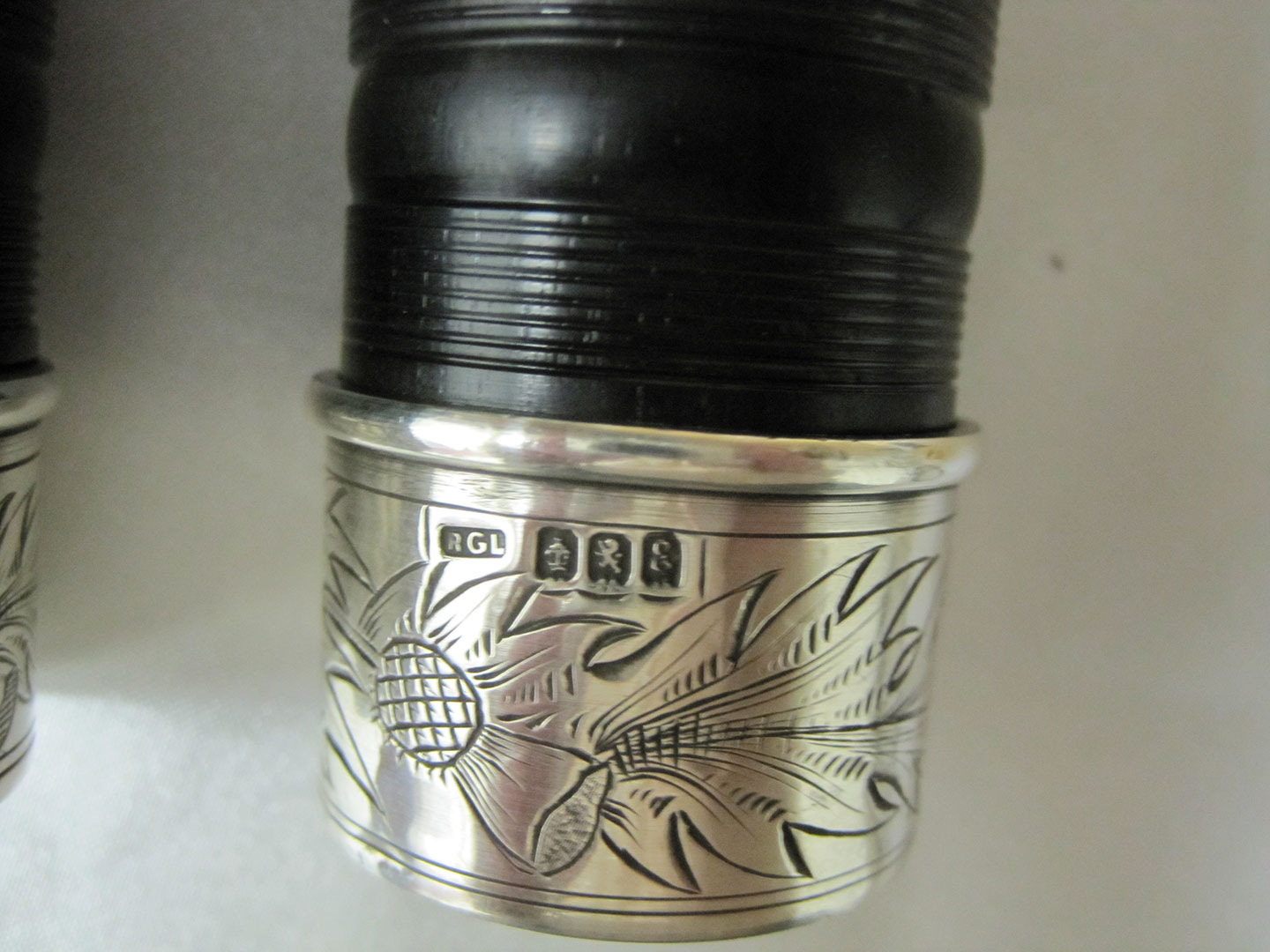As early as 1879 R.G. Lawrie was listed as a wood and ivory turner. In the 1890-1891 directory he was listed as an Ivory Turner Employer. It was not until 1900 that he would appear as a bagpipe maker.
There is speculation that he worked for Peter Henderson prior starting his own business. Some refer to their old Lawrie bagpipes as "pre-1900" or "1890". I think this is speculation and distorts that which we know as fact. Early Lawrie drones are very difficult to distinguish from Henderson drones of the same era. This lends credence to the thought that he did some work for Peter Henderson.
Silver hallmarks are helpful in establishing the date of manufacture. The earliest hallmark that I have been able to find for a Lawrie bagpipe is 1901.
There is speculation that he worked for Peter Henderson prior starting his own business. Some refer to their old Lawrie bagpipes as "pre-1900" or "1890". I think this is speculation and distorts that which we know as fact. Early Lawrie drones are very difficult to distinguish from Henderson drones of the same era. This lends credence to the thought that he did some work for Peter Henderson.
Silver hallmarks are helpful in establishing the date of manufacture. The earliest hallmark that I have been able to find for a Lawrie bagpipe is 1901.
As might be expected, Lawrie bagpipes changed over the years. I've divided this exhibit into three categories;
1. 1900 - 1910 - It is very difficult to put an exact age on any maker's bagpipe without strong evidence. When identifying a bagpipe I don't like guessing. Everytime we get it wrong we muddy the waters in our attempts to unravel the past. Paying attention to hallmarked silver, profiles, specific details, and other clues, we can get close on many sets.
At this time, I'm going to reject those who claim that their Lawrie bagpipe was made prior to 1900 unless they can provide me with irrefutable evidence to support that claim. The reason that I've chosen 1910 as a cut-off date is that we know that the straight-sided nickel ferrule with scribe lines disappeared around this time. Also, this was close to the time John MacColl became involved with the company.
The Lawrie pipes produced during this period are generally excellent, made primarily of ebony or cocuswood. They are prized as solo instruments. Silver is often without hallmarks however distinctive in style and design. I think that perhaps ebony Lawrie bagpipes are the most brilliant in sound.
2. 1910 - 1940 - With the appointment of John MacColl as Manager in 1908 some changes took place. From 1910 to about 1920, most Lawrie bagpipes were made from gaboon ebony or cocuswood. Thereafter, African Blackwood made steady gains. It was preferred by the turners as it took minimum finishing and was more durable abroad. Most of these instruments made during this years are outstanding however you can encounter those with difficult (temperamental) bass drones. It is not unusual to find Lawrie drones with either celluloid or catalin fixtures with real ivory bushings. Very odd. Also, the bead on the lower projecting mounts started growing in size. By the end of this period, projecting mounts had a pronounced "dish" in design.
3. 1940 and later - During this period we find a steady decline in the quality of the instrument. Toward the end the company stopped making bagpipes altogether. The sound became very quiet. They had a tendency to tune low on the pins and are generally considered unacceptable for competition purposes....all with one notable exception.
4. Lawrie Misc - Just this 'n that from the company. Items of interest mostly.
1. 1900 - 1910 - It is very difficult to put an exact age on any maker's bagpipe without strong evidence. When identifying a bagpipe I don't like guessing. Everytime we get it wrong we muddy the waters in our attempts to unravel the past. Paying attention to hallmarked silver, profiles, specific details, and other clues, we can get close on many sets.
At this time, I'm going to reject those who claim that their Lawrie bagpipe was made prior to 1900 unless they can provide me with irrefutable evidence to support that claim. The reason that I've chosen 1910 as a cut-off date is that we know that the straight-sided nickel ferrule with scribe lines disappeared around this time. Also, this was close to the time John MacColl became involved with the company.
The Lawrie pipes produced during this period are generally excellent, made primarily of ebony or cocuswood. They are prized as solo instruments. Silver is often without hallmarks however distinctive in style and design. I think that perhaps ebony Lawrie bagpipes are the most brilliant in sound.
2. 1910 - 1940 - With the appointment of John MacColl as Manager in 1908 some changes took place. From 1910 to about 1920, most Lawrie bagpipes were made from gaboon ebony or cocuswood. Thereafter, African Blackwood made steady gains. It was preferred by the turners as it took minimum finishing and was more durable abroad. Most of these instruments made during this years are outstanding however you can encounter those with difficult (temperamental) bass drones. It is not unusual to find Lawrie drones with either celluloid or catalin fixtures with real ivory bushings. Very odd. Also, the bead on the lower projecting mounts started growing in size. By the end of this period, projecting mounts had a pronounced "dish" in design.
3. 1940 and later - During this period we find a steady decline in the quality of the instrument. Toward the end the company stopped making bagpipes altogether. The sound became very quiet. They had a tendency to tune low on the pins and are generally considered unacceptable for competition purposes....all with one notable exception.
4. Lawrie Misc - Just this 'n that from the company. Items of interest mostly.
Click on the links below to access more words and pictures!
RG Lawrie


